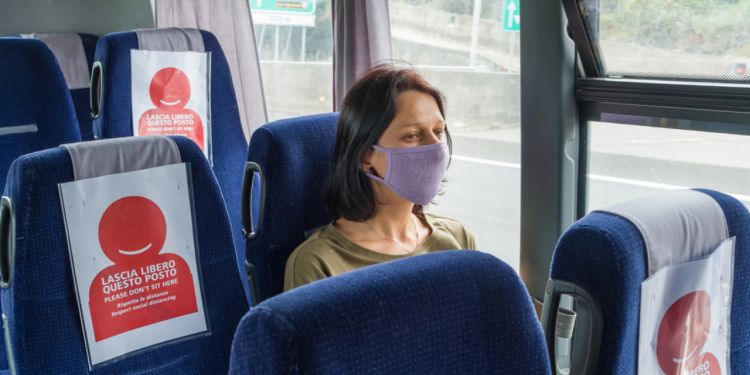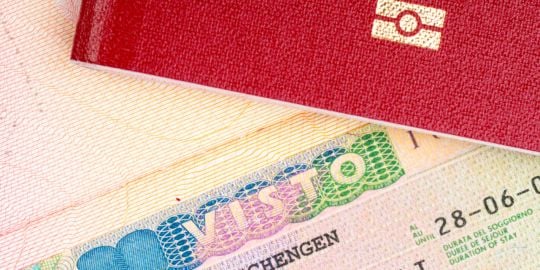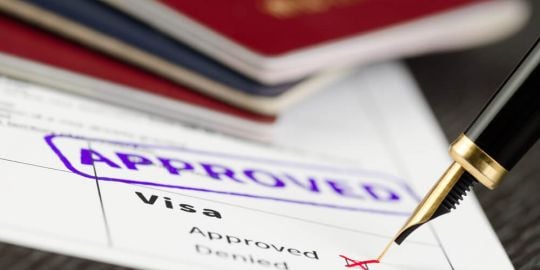Post-COVID-19 changes in Italy

Italy is one of the most affected countries by the global health crisis, so much that the lifestyle there has been transformed in a significant way. Even though the country has lifted its border restrictions, many things have changed, especially for foreigners who are looking to travel or relocate there. If you are one of them, here's what you should expect regarding entry requirements and visas, work, real estate, education, the cost of living, etc.
What are the current regulations for entering Italy?
Citizens of the European Union and the European Economic Area are allowed to enter Italy freely, regardless of the purpose of their stay. Travellers from Iceland, Liechtenstein, Norway, Switzerland, the United Kingdom, Great Britain, Northern Ireland, Andorra, the Principality of Monaco, San Marino and the Vatican are also allowed to travel there. However, there are restrictions for nationals of certain countries such as Bulgaria and Romania who must have been quarantined for 14 days prior to their arrival in Italy. Travellers from Croatia, Greece, Malta and Spain must also have been quarantined for 14 days prior to their trip to Italy and be in possession of a health certificate proving that they have tested negative for COVID-19 within 72 hours of arriving in Italy. As of August 13, 2020, if they don't have a health certificate, they have to undergo a COVID-19 test either at the port of entry as soon as possible, or at the nearest health facility of their choice within 48 hours of their arrival. During this period, they are also required to self-isolate at home. In any case, all travellers to Italy have to inform the health authorities about their arrival. If they are having COVID-19 symptoms, they are required to self-isolate immediately and to contact health authorities who will advise them for the next step. Third-country nationals are only allowed to take an essential trip to Italy, for example, in case of absolute urgency, for health reasons, for professional reasons, or to return to their place of residence. However, there are exceptions for travellers coming from Australia, Canada, Japan, Georgia, New Zealand, South Korea, Thailand, Tunisia, Rwanda, and Uruguay, as well as third-country nationals who are European Union residents, as well as their dependents. They are also required to self-isolate for 14 days following their arrival. Note that the use of public transport is not allowed upon arrival, but they can rent a car or hire a taxi. Besides, all travellers are required to provide a self-declaration form that they can download from the Ministry of Foreign Affairs and International Cooperation website. Find out more on the Ministry of Health and the Ministry of Foreign Affairs and International Cooperation website.
Have there been any visa changes recently?
For information on visa changes Italy, have a look at the Ministry of Foreign Affairs and International Cooperation website and contact the Italian embassy or consulate in your home country. For the moment, no change has been reported. However, keep an eye on the evolution of the pandemic when planning your trip to Italy, especially if you are coming from a non-European country. For example, the Italian embassy in Armenia recently announced that travellers who could not use their Schengen visa to travel to Italy during the border closure can apply for a new visa, free of charge. However, they must not have claimed a refund for their travel ticket.
Is it easy to find work in Italy following the crisis?
The coronavirus pandemic led to an economic and employment crisis in Italy, as in most countries. Despite the protection of workers' rights, the unemployment rate is expected to reach 10% by the end of 2020. From May to April, the unemployment rate had already risen from 6.3 % to 7.8%. Thus, there were 300,000 additional job seekers in the country. According to official forecasts, more than 500,000 people could lose their jobs by the end of the year, excluding people working in the informal sector. The National Statistics Office points out that 3.5 million people are not registered as employees. However, a slight improvement is expected as from 2021. The number of job vacancies in Italy has also been declining since the start of the crisis. As with most countries, travel and tourism, and aviation are the most affected sectors. Food and beverage, retail, healthcare, the automotive industry, manufacturing, construction and the production of protective equipment are also deeply impacted. Besides, many Italian companies have been forced to shut down temporarily due to loss of revenue. Finance, banking, professional services, public administration and insurance professionals were luckier as they can work from home. However, their working hours have been reduced. Many small and medium-sized enterprises that contribute significantly to the Italian economy have also become inactive due to loss of income. Therefore, the chances that you find a job in Italy after the crisis are meagre.
How has the Italian healthcare system performed during the crisis?
As mentioned above, Italy is one of the world's most affected countries, with over 260,000 COVID-19 cases and more than 35,000 deaths. The country was clearly not prepared for this type of crisis, although it has a top-notch health system. In fact, Italy has a capacity of around 3.2 hospital beds for every 1,000 patients, which is higher than in many countries. Still, the coronavirus spread rapidly throughout the country before the authorities could react. The lack of ventilators and ICU beds only worsened the situation. As a result, thousands of patients were unable to receive appropriate care in the shortest delay. Also, most patients sought healthcare from hospitals, thus increasing the infection rate. Add to this the labour shortage when nearly 30% of health professionals were contaminated due to the lack of personal protective equipment. Fortunately, Italy is being supported by many countries and international organisations. Today, Italy is benefiting from 3,500 new intensive therapy beds, 4,225 semi-intensive care beds, as well as 4 mobile units with a total of 300 beds. Emergency units have also been restructured, and the medical staff has been boosted to meet the growing demand. On the other hand, telehealth is increasingly popular with more and more appointments, medical consultations and prescriptions being carried out virtually.
Has anything changed regarding universities and schools?
Closed since March 2020 due to the lockdown, schools in Italy are reopening on September 14. The Ministry of Education has published a well-defined protocol to ensure the smooth running of the new academic year. First of all, parents are advised to avoid sending their children to school if they have an above-normal temperature and if they are having respiratory problems. In case COVID-19 cases are detected at school, they will close temporarily. The compulsory wearing of face masks has not yet been defined for children aged over 6, but it is compulsory for the teaching and non-teaching staff. Social distancing is also recommended in schools. Regarding teaching methods, schools can opt for hybrid classes on alternate days while prioritising face-to-face classes. What about higher education? International students who are looking to study in Italy are advised to postpone their plans to the second semester starting in February 2021 until July 2021, depending on how the pandemic evolves. Those who don't want to wait longer are required to adhere to certain conditions, including social distancing, the wearing of masks and the ban public gatherings. If you need a visa to study in Italy, you can already apply. However, response and processing times may be longer. A letter confirming your compulsory presence in certain classes might also be requested. Besides, international students who are required to self-isolate upon arrival in Italy must make the necessary arrangements outside the university campus, with the costs being their responsibility. For more information, please contact your university. Most universities in Italy have made distance learning arrangements for students who cannot travel to travel to Italy for the time being. On the other hand, third-country students are strongly advised to subscribe to the National Health Service to get coverage in case of COVID-19 infection. Erasmus students can also register for distance learning courses. However, to be eligible for funding, their program must comprise activities for at least 3 months.
How is the Italian real estate market following the crisis?
Unlike other European countries, the Italian real estate market is currently experiencing sharp price fluctuations. Prices have fallen slightly in some cities but increased significantly in others. According to a study by Idealista, there was a price rise in more than sixty cities in Italy, and in six others there was no change. Others have become more affordable, thanks to the pandemic. Overall, property prices across the country rose by 0.6% between May and April 2020. The most significant rises were recorded in Naples, Bologna and Turin. In Milan, on the other hand, there was a 0.8% price drop in May. It's also worth noting that thousands of property sales have been cancelled since April. Massive layoffs, wage cuts and the loss of purchasing power probably account for this situation although there is a stable demand. Nomisma, the Italian Real Estate Institute, expects around 494,000 property sales by the end of 2020 - which means an 18% drop compared to 2019. According to Knight Frank, most of the demands come from German, British and Dutch potential buyers. So if you are looking to invest in property or acquire a holiday residence in Italy, now is the time to consider the cities that have become cheaper following the pandemic.
Has the cost of living in Italy changed because of the crisis?
Prices in Italy have skyrocketed since the start of the COVID-19 crisis. Even today, many businesses are finding it hard to get back on track, although the lockdown has come to an end. Italians are paying more for most products and services, from restaurant meals to haircuts. Expect your bill to be € 2 and € 4 higher in bars and restaurants compared to the pre-COVID-19 period. However, prices vary from city to city. For example, count around 1.30 for a coffee in Florence, 1.50 € in Rome and up to 2 € in Milan. Meanwhile, the price of haircuts rose by 25%.
How about lifestyle? Have there been major changes in habits following the sanitary crisis?
In just a few months, the COVID-19 crisis has significantly transformed the lifestyle in Italy. With the lockdown that has come to an end, things are slowly improving, with people paying particular attention to government recommendations. Today, the compulsory wearing of masks if the new norm. Since August 17, 2020, it is mandatory to wear a mask in all public places, including public transport, especially when social distancing cannot be respected. This rule also applies to outdoor spaces between 6 p.m. and 6 a.m. in all places where people might gather. Public parks and gardens, theatres and cinema are all open, but social distancing is recommended. At places of worship, additional measures have been taken to avoid large gatherings. Sports activities are also allowed outdoors and in equipped areas, but a minimum 2 meters distance is required. Temperature checks are being done in places such as hotels, shops and public offices. Regarding public transport, you're advised to buy your ticket online and to observe social distancing when travelling.









